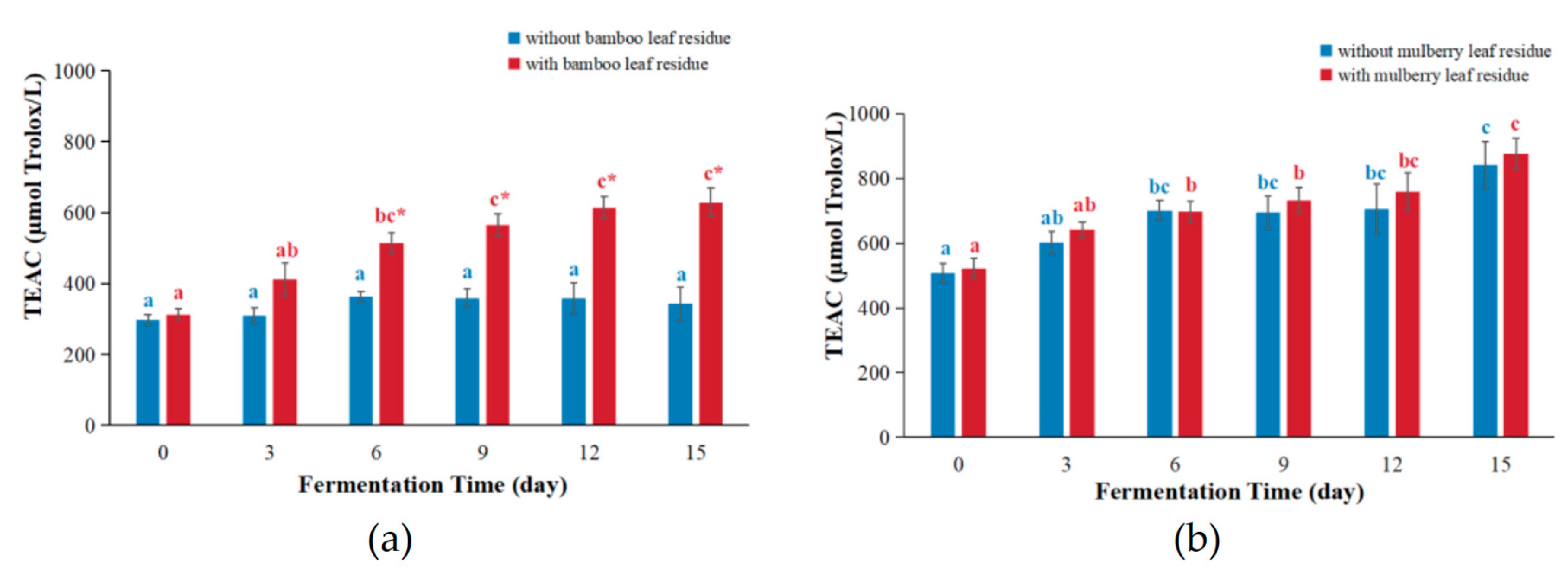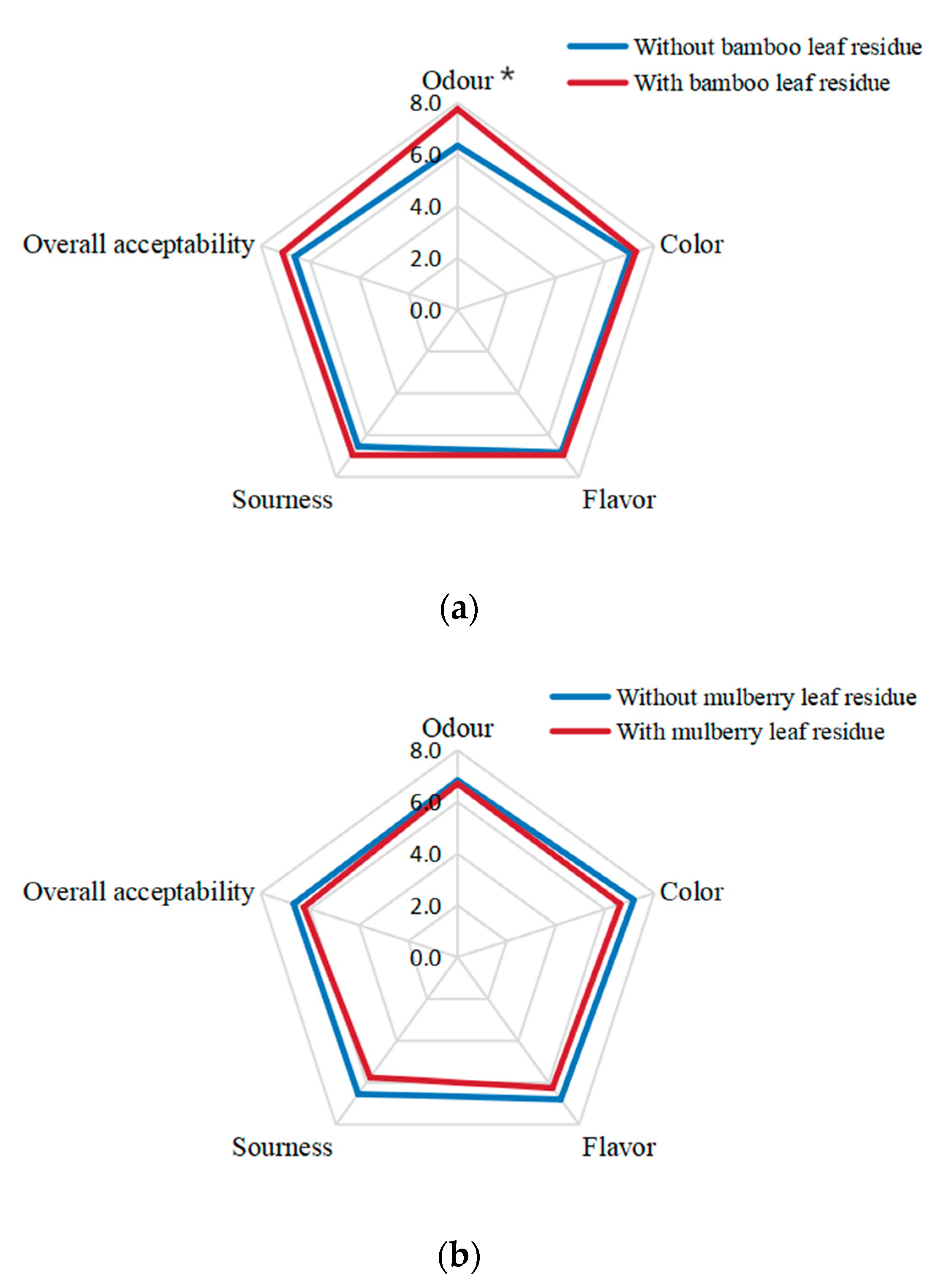Antioxidant Activities, Phenolic Compounds, and Sensory Acceptability of Kombucha-Fermented Beverages from Bamboo Leaf and Mulberry Leaf
Abstract
:1. Introduction
2. Materials and Methods
2.1. Materials and Reagents
2.2. Activation of Kombucha Starter Culture
2.3. Kombucha Preparation Based on Bamboo Leaf and Mulberry Leaf
2.4. Antioxidant Capacities and Total Phenolic Content Assessment
2.5. Evaluation of Bioactive Compounds
2.6. Sensory Pilot Study
2.7. Statistical Analysis
3. Results and Discussion
3.1. Antioxidant Activities
3.1.1. FRAP Values
3.1.2. TEAC Values
3.2. TPC Values
3.3. Concentrations of Bioactive Compounds in Kombucha
3.4. Correlations between Parameters and Concentrations of Compounds
3.5. Sensory Pilot Study
4. Conclusions
Author Contributions
Funding
Institutional Review Board Statement
Informed Consent Statement
Data Availability Statement
Acknowledgments
Conflicts of Interest
References
- de Miranda, J.F.; Ruiz, L.F.; Silva, C.B.; Uekane, T.M.; Silva, K.A.; Gonzalez, A.G.M.; Fernandes, F.F.; Lima, A.R. Kombucha: A review of substrates, regulations, composition, and biological properties. J. Food Sci. 2022, 87, 503–527. [Google Scholar] [CrossRef] [PubMed]
- Bortolomedi, B.M.; Paglarini, C.S.; Brod, F.C.A. Bioactive compounds in kombucha: A review of substrate effect and fermentation conditions. Food Chem. 2022, 385, 132719. [Google Scholar] [CrossRef] [PubMed]
- Kapp, J.M.; Sumner, W. Kombucha: A systematic review of the empirical evidence of human health benefit. Ann. Epidemiol. 2019, 30, 66–70. [Google Scholar] [CrossRef]
- Vargas, B.K.; Fabricio, M.F.; Ayub, M.A.Z. Health effects and probiotic and prebiotic potential of Kombucha: A bibliometric and systematic review. Food Biosci. 2021, 44, 101332. [Google Scholar] [CrossRef]
- Abaci, N.; Deniz, F.S.S.; Orhan, I.E. Kombucha—An ancient fermented beverage with desired bioactivities: A narrowed review. Food Chem. X 2022, 14, 100302. [Google Scholar] [CrossRef] [PubMed]
- da Silva, J.C.; Mafaldo, I.M.; Brito, I.D.; Cordeiro, A. Kombucha: Formulation, chemical composition, and therapeutic potentialities. Curr. Res. Food Sci. 2022, 5, 360–365. [Google Scholar] [CrossRef]
- Emiljanowicz, K.E.; Malinowska-Panczyk, E. Kombucha from alternative raw materials—The review. Crit. Rev. Food Sci. Nutr. 2020, 60, 3185–3194. [Google Scholar] [CrossRef]
- Saimaiti, A.; Huang, S.Y.; Xiong, R.G.; Wu, S.X.; Zhou, D.D.; Yang, Z.J.; Luo, M.; Gan, R.Y.; Li, H.B. Antioxidant capacities and polyphenol contents of kombucha beverages based on vine tea and sweet tea. Antioxidants 2022, 11, 1655. [Google Scholar] [CrossRef]
- Chan, E.W.C.; Wong, S.K.; Tangah, J.; Inoue, T.; Chan, H.T. Phenolic constituents and anticancer properties of Morus alba (white mulberry) leaves. J. Integr. Med.-JIM 2020, 18, 189–195. [Google Scholar] [CrossRef]
- He, X.Y.; Chen, X.; Ou, X.Q.; Ma, L.Y.; Xu, W.T.; Huang, K.L. Evaluation of flavonoid and polyphenol constituents in mulberry leaves using HPLC fingerprint analysis. Int. J. Food Sci. Technol. 2020, 55, 526–533. [Google Scholar] [CrossRef]
- Shin, S.O.; Seo, H.J.; Park, H.; Song, H.J. Effects of mulberry leaf extract on blood glucose and serum lipid profiles in patients with type 2 diabetes mellitus: A systematic review. Eur. J. Integr. Med. 2016, 8, 602–608. [Google Scholar] [CrossRef]
- Zhang, R.Y.; Zhang, Q.; Zhu, S.; Liu, B.Y.; Liu, F.; Xu, Y. Mulberry leaf (Morus alba L.): A review of its potential influences in mechanisms of action on metabolic diseases. Pharmacol. Res. 2022, 175, 106029. [Google Scholar] [CrossRef] [PubMed]
- Ying, C.; Mao, Y.; Chen, L.; Wang, S.; Ling, H.; Li, W.; Zhou, X. Bamboo leaf extract ameliorates diabetic nephropathy through activating the AKT signaling pathway in rats. Int. J. Biol. Macromol. 2017, 105, 1587–1594. [Google Scholar] [CrossRef] [PubMed]
- Yu, Y.; Li, Z.; Cao, G.; Huang, S.; Yang, H. Bamboo leaf flavonoids extracts alleviate oxidative stress in HepG2 cells via naturally modulating reactive oxygen species production and Nrf2-mediated antioxidant defense responses. J. Food Sci. 2019, 84, 1609–1620. [Google Scholar] [CrossRef]
- Cheng, Y.Q.; Wan, S.Q.; Yao, L.N.; Lin, D.; Wu, T.; Chen, Y.J.; Zhang, A.L.; Lu, C.F. Bamboo leaf: A review of traditional medicinal property, phytochemistry, pharmacology, and purification technology. J. Ethnopharmacol. 2023, 306, 116166. [Google Scholar] [CrossRef]
- Zhu, D.Y.; Wang, C.H.; Zhang, Y.S.; Yang, Y.; Shang, Y.F.; Niu, X.L.; Sun, L.Y.; Ma, Y.L.; Wei, Z.J. Insight into solvent effects on phenolic content and antioxidant activity of bamboo leaves extracts by HPLC analysis. J. Food Meas. Charact. 2018, 12, 2240–2246. [Google Scholar] [CrossRef]
- Zhou, D.D.; Saimaiti, A.; Luo, M.; Huang, S.Y.; Xiong, R.G.; Shang, A.; Gan, R.Y.; Li, H.B. Fermentation with tea residues enhances antioxidant activities and polyphenol contents in kombucha beverages. Antioxidants 2022, 11, 155. [Google Scholar] [CrossRef] [PubMed]
- Zhao, C.N.; Tang, G.Y.; Cao, S.Y.; Xu, X.Y.; Gan, R.Y.; Liu, Q.; Mao, Q.Q.; Shang, A.; Li, H.B. Phenolic profiles and antioxidant activities of 30 tea infusions from green, black, oolong, white, yellow and dark teas. Antioxidants 2019, 8, 215. [Google Scholar] [CrossRef] [PubMed] [Green Version]
- Tu, C.; Tang, S.; Azi, F.; Hu, W.; Dong, M. Use of kombucha consortium to transform soy whey into a novel functional beverage. J. Funct. Foods 2019, 52, 81–89. [Google Scholar] [CrossRef]
- Erskine, E.; Ozkan, G.; Lu, B.Y.; Capanoglu, E. Effects of fermentation process on the antioxidant capacity of fruit byproducts. ACS Omega 2023, 8, 4543–4553. [Google Scholar] [CrossRef]
- Hur, S.J.; Lee, S.Y.; Kim, Y.C.; Choi, I.; Kim, G.B. Effect of fermentation on the antioxidant activity in plant-based foods. Food Chem. 2014, 160, 346–356. [Google Scholar] [CrossRef]
- Yildiz, E.; Guldas, M.; Gurbuz, O. Determination of in-vitro phenolics, antioxidant capacity and bio-accessibility Kombucha tea produced from black carrot varieties grown in Turkey. Food Sci. Technol. 2021, 41, 180–187. [Google Scholar] [CrossRef]
- Zou, C.; Li, R.Y.; Chen, J.X.; Wang, F.; Gao, Y.; Fu, Y.Q.; Xu, Y.Q.; Yin, J.F. Zijuan tea- based kombucha: Physicochemical, sensorial, and antioxidant profile. Food Chem. 2021, 363, 130322. [Google Scholar] [CrossRef] [PubMed]
- Lopes, D.R.; Santos, L.O.; Prentice-Hernandez, C. Antioxidant and antibacterial activity of a beverage obtained by fermentation of yerba-mate (Ilex paraguariensis) with symbiotic kombucha culture. J. Food Process. Preserv. 2021, 45, e15101. [Google Scholar] [CrossRef]
- Li, S.Y.; Zhang, Y.; Gao, J.R.; Li, T.; Li, H.Z.; Mastroyannis, A.; He, S.; Rahaman, A.; Chang, K. Effect of fermentation time on physiochemical properties of kombucha produced from different teas and fruits: Comparative study. J. Food Qual. 2022, 2022, 2342954. [Google Scholar] [CrossRef]
- Lee, K.R.; Jo, K.; Ra, K.S.; Suh, H.J.; Hong, K.B. Kombucha fermentation using commercial kombucha pellicle and culture broth as starter. Food Sci. Technol. 2022, 42, e70020. [Google Scholar] [CrossRef]
- Değirmencioğlu, N.; Yıldız, E.; Sahan, Y.; Güldas, M.; Gürbüz, O. Impact of tea leaves types on antioxidant properties and bioaccessibility of kombucha. J. Food Sci. Technol. 2021, 58, 2304–2312. [Google Scholar] [CrossRef]
- Chakravorty, S.; Bhattacharya, S.; Chatzinotas, A.; Chakraborty, W.; Bhattacharya, D.; Gachhui, R. Kombucha tea fermentation: Microbial and biochemical dynamics. Int. J. Food Microbiol. 2016, 220, 63–72. [Google Scholar] [CrossRef] [PubMed]
- Jakubczyk, K.; Kałduńska, J.; Kochman, J.; Janda, K. Chemical profile and antioxidant activity of the kombucha beverage derived from white, green, black and red tea. Antioxidants 2020, 9, 447. [Google Scholar] [CrossRef]
- Ivanišová, E.; Meňhartová, K.; Terentjeva, M.; Harangozo, Ľ.; Kántor, A.; Kačániová, M. The evaluation of chemical, antioxidant, antimicrobial and sensory properties of kombucha tea beverage. J. Food Sci. Technol. 2020, 57, 1840–1846. [Google Scholar] [CrossRef]
- Tejedor-Calvo, E.; Morales, D. Chemical and aromatic changes during fermentation of kombucha beverages produced using strawberry tree (Arbutus unedo) fruits. Fermentation 2023, 9, 326. [Google Scholar] [CrossRef]
- Xu, X.Y.; Meng, J.M.; Mao, Q.Q.; Shang, A.; Li, B.Y.; Zhao, C.N.; Tang, G.Y.; Cao, S.Y.; Wei, X.L.; Gan, R.Y.; et al. Effects of tannase and ultrasound treatment on the bioactive compounds and antioxidant activity of green tea extract. Antioxidants 2019, 8, 362. [Google Scholar] [CrossRef] [PubMed] [Green Version]
- Li, X.B.; Tao, W.Q.; Xun, H.; Yao, X.; Wang, J.; Sun, J.; Yue, Y.D.; Tang, F. Simultaneous determination of flavonoids from bamboo leaf extracts using liquid chromatography-tandem mass spectrometry. Rev. Bras. Farmacogn.-Braz. J. Pharmacogn. 2021, 31, 347–352. [Google Scholar] [CrossRef]
- Ma, N.H.; Guo, J.; Chen, S.H.X.; Yuan, X.R.; Zhang, T.; Ding, Y. Antioxidant and compositional HPLC analysis of three common bamboo leaves. Molecules 2020, 25, 409. [Google Scholar] [CrossRef] [PubMed] [Green Version]
- Ye, S.; Pan, F.; Yao, L.; Fang, H.; Cheng, Y.; Zhang, Z.; Chen, Y.; Zhang, A. Isolation, characterization of bamboo leaf flavonoids by size exclusion chromatography and their antioxidant properties. Chem. Biodivers. 2022, 19, e202200506. [Google Scholar] [CrossRef]











Disclaimer/Publisher’s Note: The statements, opinions and data contained in all publications are solely those of the individual author(s) and contributor(s) and not of MDPI and/or the editor(s). MDPI and/or the editor(s) disclaim responsibility for any injury to people or property resulting from any ideas, methods, instructions or products referred to in the content. |
© 2023 by the authors. Licensee MDPI, Basel, Switzerland. This article is an open access article distributed under the terms and conditions of the Creative Commons Attribution (CC BY) license (https://creativecommons.org/licenses/by/4.0/).
Share and Cite
Xiong, R.-G.; Wu, S.-X.; Cheng, J.; Saimaiti, A.; Liu, Q.; Shang, A.; Zhou, D.-D.; Huang, S.-Y.; Gan, R.-Y.; Li, H.-B. Antioxidant Activities, Phenolic Compounds, and Sensory Acceptability of Kombucha-Fermented Beverages from Bamboo Leaf and Mulberry Leaf. Antioxidants 2023, 12, 1573. https://doi.org/10.3390/antiox12081573
Xiong R-G, Wu S-X, Cheng J, Saimaiti A, Liu Q, Shang A, Zhou D-D, Huang S-Y, Gan R-Y, Li H-B. Antioxidant Activities, Phenolic Compounds, and Sensory Acceptability of Kombucha-Fermented Beverages from Bamboo Leaf and Mulberry Leaf. Antioxidants. 2023; 12(8):1573. https://doi.org/10.3390/antiox12081573
Chicago/Turabian StyleXiong, Ruo-Gu, Si-Xia Wu, Jin Cheng, Adila Saimaiti, Qing Liu, Ao Shang, Dan-Dan Zhou, Si-Yu Huang, Ren-You Gan, and Hua-Bin Li. 2023. "Antioxidant Activities, Phenolic Compounds, and Sensory Acceptability of Kombucha-Fermented Beverages from Bamboo Leaf and Mulberry Leaf" Antioxidants 12, no. 8: 1573. https://doi.org/10.3390/antiox12081573
APA StyleXiong, R.-G., Wu, S.-X., Cheng, J., Saimaiti, A., Liu, Q., Shang, A., Zhou, D.-D., Huang, S.-Y., Gan, R.-Y., & Li, H.-B. (2023). Antioxidant Activities, Phenolic Compounds, and Sensory Acceptability of Kombucha-Fermented Beverages from Bamboo Leaf and Mulberry Leaf. Antioxidants, 12(8), 1573. https://doi.org/10.3390/antiox12081573






